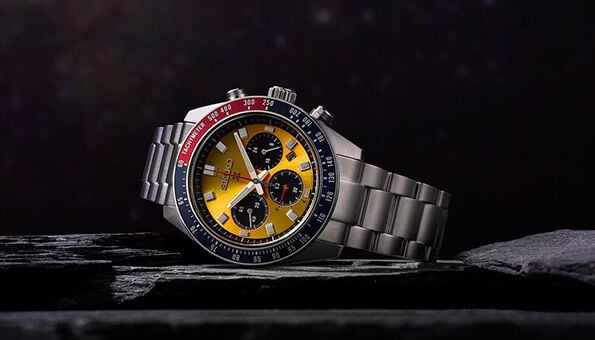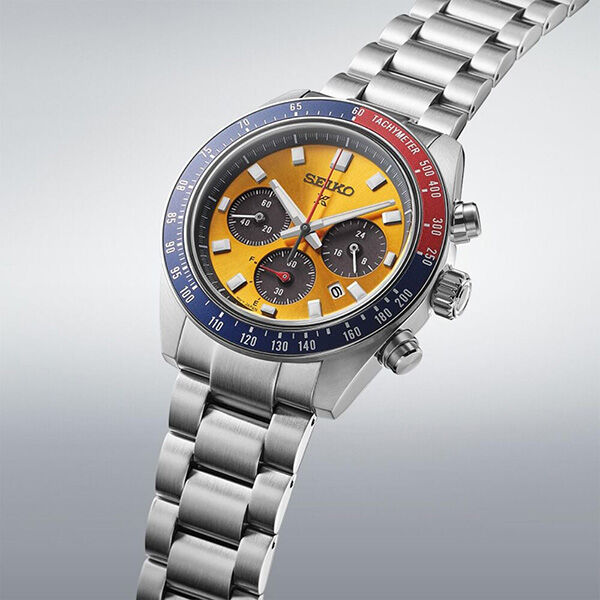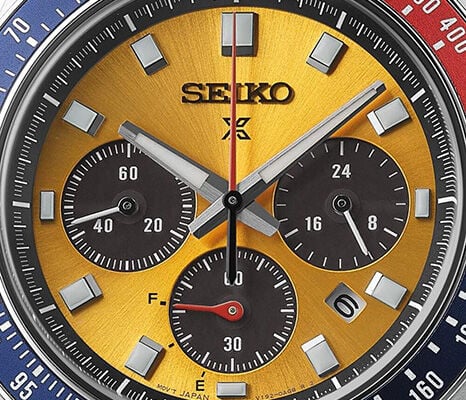THE SEIKO POGUE LEGACY: PAST MEETS PRESENT
What makes a watch truly iconic?
In 1972, NASA astronaut Colonel William Pogue unknowingly turned a Seiko watch into a legend. The Seiko 6139, with its eye-catching yellow dial and vibrant bezel, became the first automatic chronograph worn in space.
Join us as we explore the captivating story of the Seiko Pogue and unveil its modern successor, the Seiko Prospex Pogue Solar Chronograph 1969 Re-Interpretation.
The Seiko Pogue Story
In 1972, NASA astronaut Colonel William Pogue bought a Seiko watch, unintentionally turning it into a space icon. Pogue wasn’t supposed to wear it, but the Seiko 6139, with its sporty chronograph, vivid yellow dial, red accents, and blue and red bezel, became one of the brand’s most iconic watches.
The automatic chronograph, which Pogue took into space, is legendary. While he did receive an Omega Speedmaster for his mission, he trained with the Seiko 6139. Even during the Skylab 4 mission from November 16, 1973, to February 8, 1974, he brought along his Seiko.
Years later, it was revealed that Pogue used his Seiko Chronograph to time thruster burns, making it the first automatic chronograph worn in space. This discovery in 2006 stirred some controversy since Seiko wasn’t officially sanctioned by NASA. However, Seiko’s reliable magic lever winding system performed flawlessly in space, earning the brand significant respect. To celebrate this unique achievement, Seiko has released a commemorative timepiece that blends the past and the present.
The New Seiko Prospex Pogue Solar Chronograph 1969 Re-Interpretation
The new Seiko Prospex Pogue Solar Chronograph 1969 Re-Interpretation retains the distinctive coloring of the original. The bezel is aluminum with red and blue hues, featuring a white tachymeter scale. The yellow dial with red chronograph hands includes three sub-counters at 3, 6, and 9 o’clock, offering a 24-hour timer, a 60-minute counter in 1/5th increments, and a small seconds counter. The baton hour markers are coated with luminous material, and the grey-black chronometer second scale is protected by anti-reflective, scratch-resistant sapphire crystal glass.
The 41.4mm stainless steel case maintains the vintage style, complete with a screw-down crown for 100-meter water resistance. This watch is designed for everyday wear, including showers, without damaging the internal components.
The retro design of the Seiko Prospex Pogue Solar Chronograph 1969 Re-Interpretation is eye-catching and a great conversation starter. The stainless steel bracelet, with brushed and polished finishes, is ergonomically designed for comfort and pairs well with sophisticated attire.
One significant update is the in-house Calibre V192 movement, a solar-powered mechanism with an accuracy of -15/+15 seconds per month. Fully charged, it offers a 6-month power reserve, making it an economical choice.
Whether you're a space enthusiast, sports watch collector, or Seiko fan, the new Seiko Prospex Pogue Solar Chronograph 1969 Re-Interpretation is a must-have addition to your collection.
Act quickly to be among the first to wear this iconic piece.





